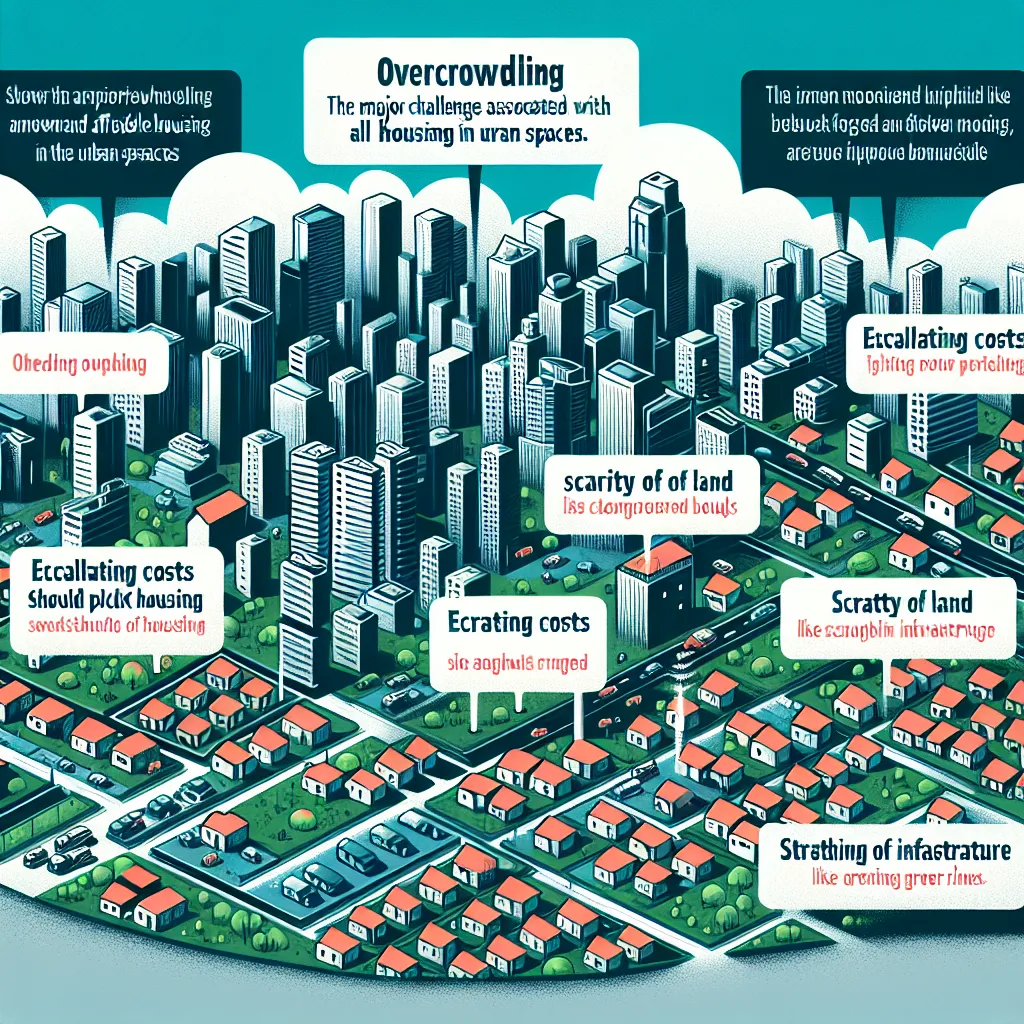The IELTS Reading section is a crucial component of the test, assessing your ability to comprehend complex texts and extract relevant information. Today, we’ll focus on a topic that has been increasingly prevalent in recent IELTS exams: the challenges of affordable housing. This subject has appeared in various forms over the past few years, reflecting its growing importance in urban development and social policy discussions worldwide.
Given its relevance to current global issues, there’s a high probability that you might encounter a similar topic in your upcoming IELTS test. Let’s dive into a practice exercise that will help you prepare for this potential challenge while honing your reading skills.
 Urban housing challenges
Urban housing challenges
Reading Passage
The Affordable Housing Crisis: A Global Challenge
The issue of affordable housing has become a pressing concern for cities around the world. As urban populations continue to grow at an unprecedented rate, the demand for housing has skyrocketed, leading to a crisis that affects millions of people. This problem is particularly acute in major metropolitan areas, where the cost of living has far outpaced wage growth, leaving many residents struggling to find suitable accommodation within their means.
One of the primary challenges in providing affordable housing is the scarcity of available land in urban centers. As cities become more densely populated, vacant plots become increasingly rare and expensive. This scarcity drives up the cost of development, making it difficult for builders to construct housing units that are both profitable and affordable for low to middle-income families.
Another significant obstacle is the complex web of regulations and zoning laws that govern urban development. While these regulations are often designed to ensure safety and maintain the character of neighborhoods, they can also inadvertently hinder the construction of affordable housing. Height restrictions, minimum parking requirements, and lengthy approval processes can all add to the cost and complexity of developing affordable housing projects.
The affordability crisis is further exacerbated by the phenomenon of gentrification. As certain neighborhoods become more desirable, property values and rents increase, often displacing long-time residents who can no longer afford to live in their communities. This process not only disrupts social cohesion but also puts additional pressure on the already strained affordable housing market.
Governments and policymakers have attempted to address these challenges through various initiatives. Subsidies, tax incentives, and inclusionary zoning policies are among the tools used to encourage the development of affordable housing. However, these measures often fall short of meeting the growing demand, particularly in rapidly expanding urban areas.
Innovative solutions are emerging to tackle the affordable housing crisis. Modular construction techniques, for instance, offer the potential to reduce building costs and timelines significantly. Additionally, the adaptive reuse of existing structures, such as converting old office buildings or warehouses into residential units, presents an opportunity to create affordable housing without the need for new land development.
Despite these efforts, the affordable housing challenge remains a complex and multifaceted issue. It requires a coordinated approach involving government agencies, private developers, and community organizations. As cities continue to grow and evolve, finding sustainable solutions to the affordable housing crisis will be crucial for ensuring the long-term health and viability of urban communities worldwide.
Questions
True/False/Not Given
For questions 1-5, please indicate whether the statements are True, False, or Not Given based on the information provided in the passage.
- The affordable housing crisis is primarily a problem in developing countries.
- Land scarcity in urban areas contributes to the high cost of housing development.
- Zoning laws are designed specifically to prevent the construction of affordable housing.
- Gentrification can lead to the displacement of long-term residents in certain neighborhoods.
- Modular construction techniques have been proven to solve the affordable housing crisis entirely.
Multiple Choice
Choose the correct letter, A, B, C, or D for questions 6-8.
-
According to the passage, which of the following is NOT mentioned as a challenge to providing affordable housing?
A) Limited availability of land
B) Complex regulations
C) Lack of skilled construction workers
D) Gentrification -
The passage suggests that subsidies and tax incentives:
A) Have completely solved the affordable housing crisis
B) Are ineffective and should be discontinued
C) Have not fully met the demand for affordable housing
D) Are only used in developing countries -
Which of the following is presented as a potential solution to the affordable housing crisis?
A) Increasing minimum wage
B) Adaptive reuse of existing structures
C) Restricting urban population growth
D) Eliminating all zoning laws
Matching Information
Match the following statements (questions 9-13) with the correct paragraph (A-G) from the passage. You may use any paragraph more than once.
- Describes how changing neighborhood demographics can affect housing affordability
- Mentions strategies used by governments to promote affordable housing development
- Explains why building affordable housing in cities is expensive
- Discusses new methods that could reduce the cost of constructing affordable homes
- Outlines the overall scope and importance of the affordable housing problem
Answer Key
- Not Given
- True
- False
- True
- False
- C
- C
- B
- Paragraph 4
- Paragraph 5
- Paragraph 2
- Paragraph 6
- Paragraph 1
Explanations
-
The passage does not specifically state whether the affordable housing crisis is primarily a problem in developing countries or not. It mentions it as a global issue without specifying particular types of countries.
-
The second paragraph explicitly states that land scarcity in urban areas drives up the cost of development.
-
The passage states that zoning laws are designed to ensure safety and maintain neighborhood character, not specifically to prevent affordable housing construction.
-
Paragraph 4 directly mentions that gentrification can displace long-time residents who can no longer afford to live in their communities.
-
While modular construction is mentioned as a potential solution, the passage does not claim it has entirely solved the crisis.
-
The passage does not mention a lack of skilled construction workers as a challenge to providing affordable housing.
-
The passage states that subsidies and tax incentives “often fall short of meeting the growing demand,” indicating they have not fully solved the crisis.
-
Adaptive reuse of existing structures is explicitly mentioned as a potential solution in paragraph 6.
-
Paragraph 4 discusses gentrification and its effects on housing affordability in changing neighborhoods.
-
Paragraph 5 lists various initiatives used by governments to encourage affordable housing development.
-
Paragraph 2 explains how land scarcity in urban areas makes building affordable housing expensive.
-
Paragraph 6 discusses innovative solutions like modular construction that could reduce housing construction costs.
-
The first paragraph provides an overview of the affordable housing crisis and its global significance.
Common Mistakes
When tackling a reading passage like this, students often make the following mistakes:
-
Overlooking key qualifiers: Words like “often,” “can,” or “may” are crucial in determining whether a statement is true or false.
-
Making assumptions: Some students might assume information based on their own knowledge rather than strictly adhering to the passage content.
-
Misinterpreting “Not Given”: Remember, “Not Given” means the information is neither confirmed nor denied in the passage.
-
Failing to match paragraph information accurately: It’s essential to read each paragraph carefully and understand its main idea.
-
Rushing through the questions: Take your time to understand each question and refer back to the passage as needed.
Vocabulary
Here are some challenging words from the passage along with their definitions:
-
Unprecedented (adjective) /ʌnˈpres.ɪ.den.tɪd/: Never having happened or existed before
-
Acute (adjective) /əˈkjuːt/: Very severe or intense
-
Exacerbate (verb) /ɪɡˈzæs.ər.beɪt/: To make a bad situation even worse
-
Gentrification (noun) /ˌdʒen.trɪ.fɪˈkeɪ.ʃən/: The process of changing the character of a poor urban area through the influx of more affluent residents
-
Inadvertently (adverb) /ˌɪn.əˈvɜː.tənt.li/: Without intention; accidentally
Grammar Focus
Pay attention to the use of complex sentences in the passage. For example:
“While these regulations are often designed to ensure safety and maintain the character of neighborhoods, they can also inadvertently hinder the construction of affordable housing.”
This sentence uses a concessive clause (introduced by “while”) to present contrasting ideas. It’s a common structure in academic writing to show a balanced perspective on complex issues.
Tips for Success
-
Practice active reading: Underline key points and make mental notes as you read.
-
Improve your time management: Allocate your time wisely between reading and answering questions.
-
Expand your vocabulary: Regularly learn new words related to urban development and social issues.
-
Familiarize yourself with various question types: Practice with different formats like True/False/Not Given, Multiple Choice, and Matching Information.
-
Read widely on current affairs: Many IELTS Reading passages are based on contemporary global issues like affordable housing.
By focusing on these areas and practicing regularly with passages like this one, you’ll be well-prepared to tackle the IELTS Reading section confidently. Remember, the key to success in IELTS Reading is a combination of strong vocabulary, effective time management, and critical reading skills.
For more practice on related topics, check out our articles on challenges in managing overpopulation and urbanization and the challenge of affordable housing. These will provide additional context and vocabulary that could be useful in your IELTS preparation.


